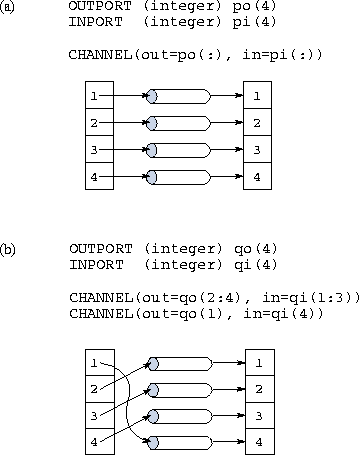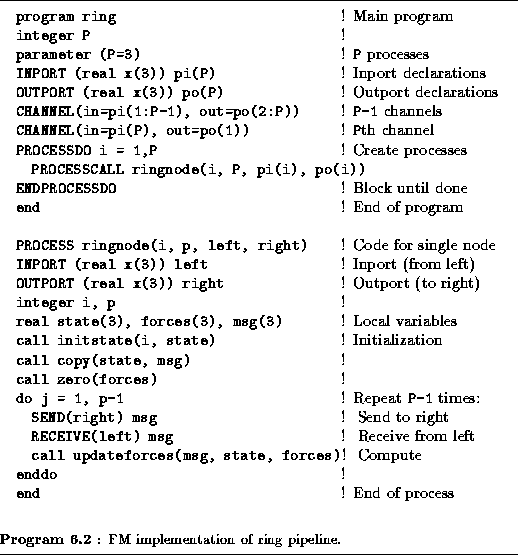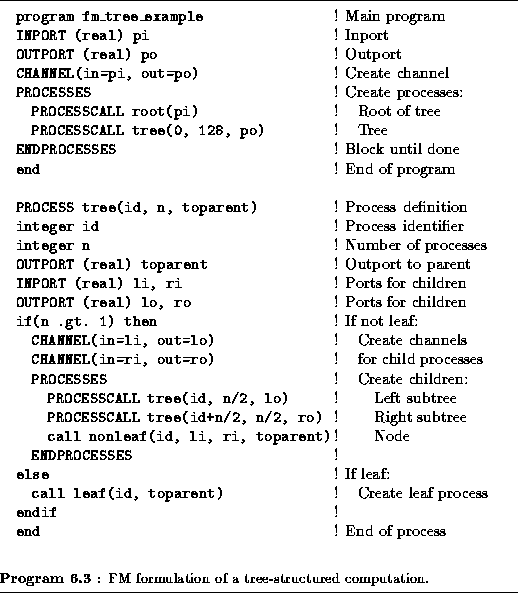![[DBPP]](pictures//asm_color_tiny.gif)





![[Search]](pictures//search_motif.gif)
Next: 6.4 Unstructured Communication
Up: 6 Fortran M
Previous: 6.2 Concurrency
FM processes, like the tasks introduced in Part I, cannot share data
directly. Instead, they coordinate their execution and exchange data
by sending and receiving messages on single-producer, single-consumer
channels and multiple-producer, single-consumer mergers. Hence, the
next step in program implementation after processes have been defined
is to establish the channels and mergers needed for communication.
In this section, we focus on the constructs and techniques used to
specify structured, ``synchronous'' communication operations
(Section 2.3). In subsequent sections we examine both
unstructured and asynchronous communication.
The basic building block from which communication structures are
constructed is the channel, created by executing the CHANNEL
statement. This statement has the general form
CHANNEL(in= inport, out= outport )
and both creates a new channel and defines inport
and
outport
to be references to this channel, with inport
able to receive messages and outport
able to send messages.
The two ports must be of the same type.
Optional iostat= and err= specifiers can be used to detect
error conditions, as in Fortran file input/output statements. An
err= label
specifier causes execution to continue at the
statement with the specified label
if an error occurs while
creating the channel. An iostat= intval
specifier
causes the integer variable intval
to be set to zero if no
error occurs and to a nonzero value otherwise. If neither err=
nor iostat= specifiers are provided, an error causes the FM
computation to terminate.
For succinctness, we use Fortran 90 array sections
in the
CHANNEL statement. An array section is like an array element
but with a range rather than an index provided for one or more of its
subscripts. A range is represented by a triplet with the following
general form.
lower-bound
: upper-bound
: stride
Bounds
can be omitted if the corresponding bounds of the array are required;
a stride of 1 is assumed if stride
is omitted.
See Figure 7.1 in Chapter 7 for examples
of array sections.
Array sections provided in the in= and out= components of
a CHANNEL statement must be conformant, that is, of the same
size and shape. A channel is created for each pair of corresponding
elements, as illustrated in Figure 6.1.

Figure 6.1: Array sections and the FM CHANNEL statement.
In (a), a single statement creates four channels and, for i=1..4
,
defines outport po( i
) and inport pi( i
) to
reference the same channel. Hence, for example, a message sent on
po(1) can be received on pi(1). In (b), two statements
are used to define a ``staggered'' mapping of inports to outports, in
which outport qo(mod( i
,4)+1) and inport qi( i
)
reference the same channel. Therefore, a message sent on qo(1) can
be received on qi(4).
A process sends a message by applying the SEND statement to an
outport. Doing this adds the message to the message queue associated
with the outport, with the outport declaration specifying the message
format. For example, in the following code fragment the SEND
statement sends a message consisting of the integer i followed
by the first ten elements of the real array a.
OUTPORT (integer, real x(10)) po
...
SEND(po) i, a
A process sends a sequence of messages by repeated calls to
SEND; it can also call ENDCHANNEL to send an end-of-channel
(EOC) message. This usage is illustrated in
Program 6.1, where the foundry process uses the
SEND and ENDCHANNEL statements to send a total of 100
integer messages. ENDCHANNEL also sets the value of the outport
variable to be NULL, thereby preventing further messages from
being sent on that port.
Like Fortran's write and endfile statements, SEND
and ENDCHANNEL are nonblocking (asynchronous); that is, they complete
immediately. Variables named in a SEND statement can be
modified in subsequent statements, without affecting the send
operation.
An operation on an undefined port is treated as erroneous. Optional
err= and iostat= specifiers (described in
Section 6.3.1) can be included in SEND and
ENDCHANNEL statements to indicate how to recover from this and other
exceptional conditions.
A process receives a value by applying the RECEIVE statement to
an inport. The inport declaration specifies the message format. For
example, the bridge process in Program 6.1 makes
repeated calls to the RECEIVE statement to receive a sequence of
integer messages, detecting end-of-sequence by using the iostat
specifier. A RECEIVE statement is blocking (synchronous); that is, it
does not complete until data is available. Hence, a consumer process
such as bridge cannot ``run ahead'' of the corresponding
producer.
An array size can be included in a message, thereby allowing arrays of
different sizes to be communicated on the same channel. For example,
the following code fragment receives a message comprising the integer
num followed by num real values. The incoming data are
placed in array elements a(1,offset), a(1,offset+1), ...,
a(1,offset+num-1).
INPORT (integer n, real x(n)) pi
integer num
real a(128, 128)
RECEIVE(pi) num, a(1,offset)
An operation on an undefined port is treated as erroneous. A
RECEIVE statement can include optional err= and iostat=
specifiers to indicate how to recover from this and various
exceptional conditions. In addition, an end= label
specifier causes execution to continue at the statement with the
specified label
upon receipt of a end-of-channel message.
This mechanism can be used to rewrite the bridge process of
Program 6.1 as follows.
PROCESS bridge(pi) ! Process definition
INPORT (integer) pi ! Argument: inport
integer num ! Local variable
do while(.true.) ! While not done:
RECEIVE(port=pi, end=10) num ! Receive message
call use_girder(num) ! Process message
enddo !
10 end ! End of process
Example  .
. Ring Pipeline:
Ring Pipeline:
Program 6.2 implements the ring-based pairwise
interactions algorithm of Section 1.4.2. It comprises
a main program and a process definition. The main program uses two
channel statements to create P channels
(Figure 6.1) and a process do-loop to create P
processes. One inport and one outport are passed to each process as
arguments, thereby connecting the processes in a unidirectional ring
(Figure 6.2). The variables i and P are
also passed to the processes as arguments; this capability is
discussed in Section 6.7.
The ringnode process's four arguments are a unique identifier,
the total number of processes, and an inport and outport referencing
channels from one neighbor and to the other neighbor in the ring. The
process first initializes its local state and then performs n-1
send-receive-compute steps before terminating.


Figure 6.2: FM implementation of three-process ring pipeline showing channel
connections.
Example  .
. Search:
Search:
Program 6.3 implements a prototypical tree-structured
computation. The program explores a binary tree recursively in the
manner of
Algorithm 1.1, creating a task for each tree node and
returning the total number of leaf nodes that represent solutions. In
this simple program, the tree is not represented by an explicit data
structure; instead, a process's position in the tree is represented by
an integer.
The main program makes an initial call to the process tree.
This process uses a process block to create recursively a set of
2n-1
( n
a power of 2) processes connected in a binary tree
of depth  . Each process is connected to its parent by a
channel; nonleaf processes also have channels from their two
offspring. Notice the use of a subroutine call within a process
block, as discussed in Section 6.2.2.
. Each process is connected to its parent by a
channel; nonleaf processes also have channels from their two
offspring. Notice the use of a subroutine call within a process
block, as discussed in Section 6.2.2.

![[DBPP]](pictures//asm_color_tiny.gif)





![[Search]](pictures//search_motif.gif)
Next: 6.4 Unstructured Communication
Up: 6 Fortran M
Previous: 6.2 Concurrency
© Copyright 1995 by Ian Foster

![[DBPP]](pictures//asm_color_tiny.gif)





![[Search]](pictures//search_motif.gif)
 .
. Ring Pipeline:
Ring Pipeline:


 .
. Search:
Search:
 . Each process is connected to its parent by a
channel; nonleaf processes also have channels from their two
offspring. Notice the use of a subroutine call within a process
block, as discussed in Section
. Each process is connected to its parent by a
channel; nonleaf processes also have channels from their two
offspring. Notice the use of a subroutine call within a process
block, as discussed in Section 